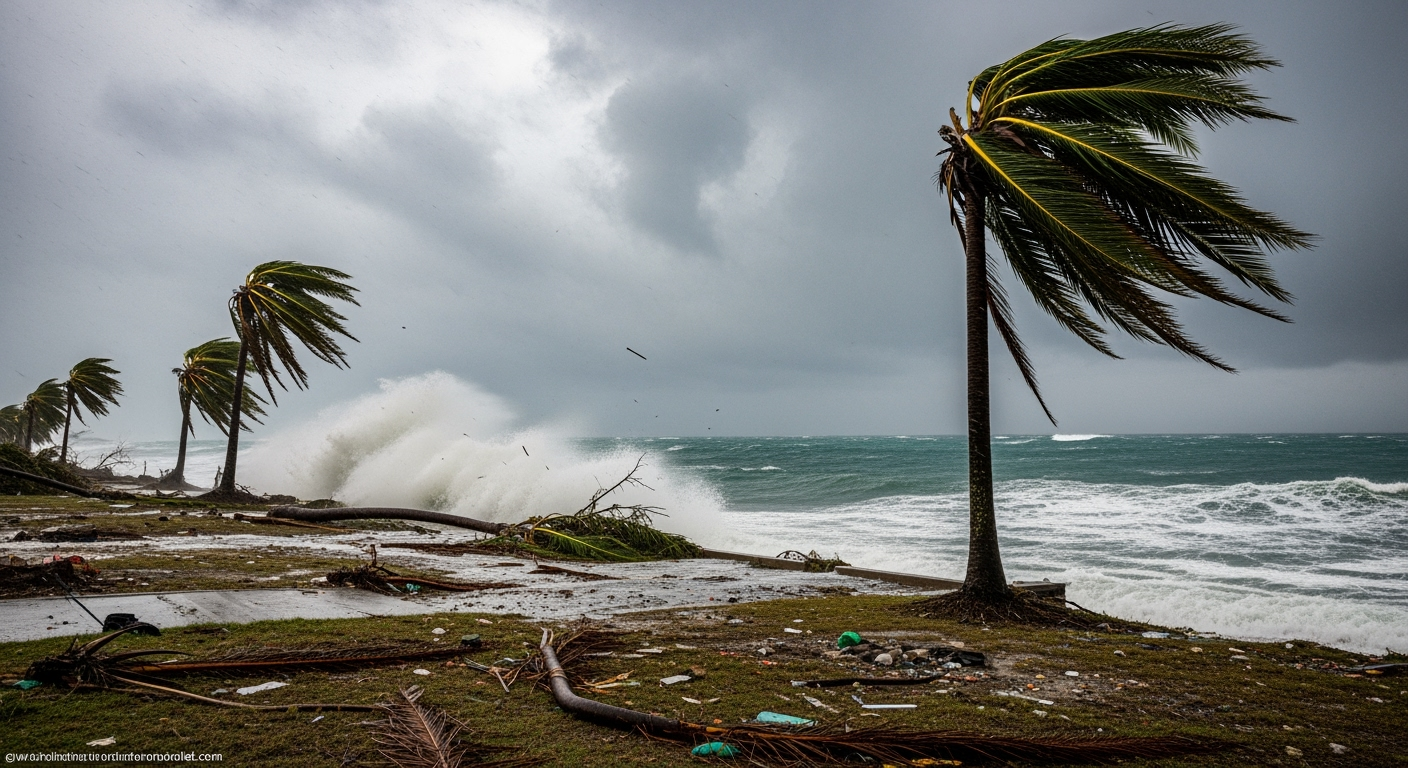Related Articles

Japan Deploys Military as Deadly Bear Attacks Reach Unprecedented Levels, Sparking National Concern

African Union Condemns 'War Crimes' as RSF Captures El Fasher, Deepening Sudan's Humanitarian Crisis





Kingston, Jamaica – In a development poised to reshape the nation's history, Hurricane Melissa, a monstrous Category 5 storm packing sustained winds of up to 165 miles per hour (270 kph), is bearing down on Jamaica, threatening to unleash an unprecedented level of devastation. Forecasters warn that Melissa is set to become the strongest hurricane ever to make a direct landfall on the island since record-keeping began in 1851, eclipsing even the destructive power of 1988's Hurricane Gilbert. As of Monday, October 27, 2025, the slow-moving system is just hours away from the southern coast, prompting urgent mass evacuations and a frantic scramble to prepare for what authorities are calling a potential "humanitarian crisis."
Hurricane Melissa underwent rapid intensification over the weekend, escalating to a Category 5 on the Saffir-Simpson scale — the highest possible classification — by Monday morning. With maximum sustained winds registering between 160 and 165 mph, and inching westward at a perilous 3-5 mph, the storm’s slow traversal is expected to exacerbate its impact, prolonging the exposure to torrential rainfall and destructive winds across the island. Chief meteorologist Jonathan Porter of AccuWeather stated that Melissa would be the strongest hurricane in recorded history to directly impact Jamaica. This projection highlights the exceptional danger posed by Melissa, far exceeding the strength of previous significant storms like Hurricane Gilbert, which made landfall as a high-end Category 3. The U.S. National Hurricane Center (NHC) has issued dire warnings, emphasizing the likelihood of "catastrophic and life-threatening flash flooding," numerous landslides, and "destructive winds" expected to engulf Jamaica from late Monday into Tuesday.
The scale of anticipated destruction from Hurricane Melissa is staggering, encompassing a trifecta of extreme weather phenomena. Rainfall totals could reach an astounding 30 to 40 inches (1 meter) in eastern Jamaica, particularly within the mountainous regions, almost half of Kingston's typical annual rainfall. Such extreme precipitation will inevitably trigger catastrophic flash flooding and widespread landslides, isolating communities and rendering many areas impassable.
Compounding the inland flood threat is a life-threatening storm surge projected to reach 9 to 13 feet (4 meters) along the southern coast. This surge poses a severe risk to low-lying coastal parishes such as Westmoreland, Saint Elizabeth, Manchester, and Clarendon. Critically, vital infrastructure, including Kingston's main international airport and several power plants, are situated in these vulnerable coastal zones, making them highly susceptible to inundation and severe damage. Category 5 winds are capable of causing widespread structural failure, tearing roofs from buildings, collapsing walls, and felling trees and power poles across broad areas, leading to extensive infrastructural damage and prolonged power and communication outages. The NHC explicitly warned residents not to venture out of shelters once the storm hits, underscoring the extreme dangers posed by Melissa's destructive capabilities.
In response to the looming threat, Jamaican authorities have initiated an unprecedented, island-wide mobilization effort. The Office of Disaster Preparedness and Emergency Management (ODPEM) has fully activated the National Emergency Operation Centre (NEOC) at a high alert level, along with all Parish Emergency Operations Centers and emergency shelters. More than 800 shelters have been opened across the island, though initial reports indicated low occupancy rates on Sunday night, prompting officials to intensify calls for immediate evacuation.
Mandatory evacuation orders have been issued for seven flood-prone communities, with buses deployed to transport residents to safer locations. Desmond McKenzie, Jamaica's Minister of Local Government, urged citizens to take the threat seriously, stating, "Many of these communities will not survive this flooding." The Jamaica Red Cross (JRC) has been actively preparing for Melissa for a week, pre-positioning emergency supplies such as shelter kits, hygiene kits, and tarpaulins, and supporting alerts and evacuations in areas at risk. The Ministry of Tourism has also activated its Emergency Operation Centre, coordinating the structured departure of visitors and establishing emergency shelter facilities for those unable to leave. Despite these efforts, the sheer magnitude of Melissa presents immense challenges, particularly for communities still recovering from Hurricane Beryl, which caused significant damage just over a year ago.
Before approaching Jamaica, Hurricane Melissa had already left a trail of destruction across the northern Caribbean. The slow-moving storm has been blamed for at least three deaths in Haiti and one in the Dominican Republic, where another person remains missing. In Haiti, Melissa destroyed crops across three regions, including 37 acres of maize, exacerbating an already dire hunger crisis affecting over half of the country's population. The United Nations' Food and Agriculture Organization warned that "flooding is obstructing access to farmland and markets, jeopardizing harvests and the winter agricultural season."
The human stories behind the storm's statistics are beginning to emerge. Hanna Mcleod, a 23-year-old hotel receptionist in Kingston, described boarding up her home and stocking up on supplies, expressing her deep worry as she experiences a hurricane of this magnitude for the first time. Such accounts underscore the profound anxiety and uncertainty gripping the island as it braces for an unparalleled natural disaster. Experts warn that the anticipated widespread damage, prolonged power outages, and communication disruptions will severely delay cleanup and damage assessment efforts, posing a significant challenge to recovery in the aftermath of Melissa.
As Hurricane Melissa makes its imminent landfall, Jamaica stands at a critical juncture. The island faces the immense task of enduring an unprecedented natural disaster, with projections of catastrophic flooding, life-threatening storm surges, and destructive winds. The comprehensive preparedness efforts by governmental and non-governmental agencies are underway, aiming to mitigate the humanitarian impact. However, the sheer force of this Category 5 storm, coupled with its slow movement and the pre-existing vulnerabilities from previous storms, suggests a long and arduous path to recovery for the resilient people of Jamaica. The world watches anxiously as Melissa writes a new, grim chapter in the nation's hurricane history.